
Treia is a town and comune in the province of Macerata in the central Marche (Italy). It is 7 kilometres (4.3 mi) north of Pollenza, 12 kilometres (7.5 mi) west of Macerata, and 18 kilometres (11 mi) north-northeast of Tolentino.

Macerata is a city and comune in central Italy, the county seat of the province of Macerata in the Marche region. It has a population of about 41,564.

Sentinum was a Roman town now located about a kilometre south of the present-day town of Sassoferrato in the Marche region of Italy.
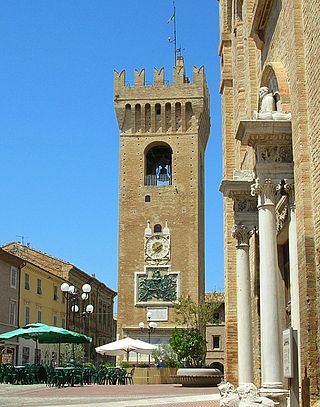
Recanati is a town and comune in the Province of Macerata, in the Marche region of Italy. Recanati was founded around 1150 AD from three pre-existing castles. In 1290 it proclaimed itself an independent republic and, in the 15th century, was famous for its international fair. In March 1798 it was conquered by Napoleon Bonaparte.

Picenum was a region of ancient Italy. The name was assigned by the Romans, who conquered and incorporated it into the Roman Republic. Picenum became Regio V in the Augustan territorial organisation of Roman Italy. It is now in Marche and the northern part of Abruzzo.
The year 1971 in archaeology involved some significant events.
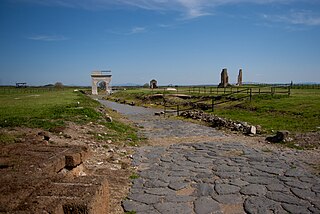
Vulci or Volci was a rich Etruscan city in what is now northern Lazio, central Italy.

Potenza is a comune in the Southern Italian region of Basilicata.

Suasa was an ancient Roman town in what is now the comune of Castelleone di Suasa, Marche, Italy. It is located in the Pian Volpello locality, in the valley of the Cesano River.
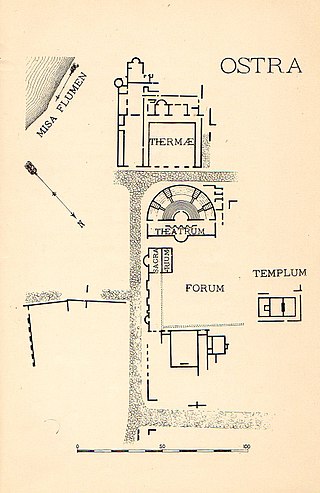
Ostra was an ancient Roman town near the modern town of Ostra Vetere. The Roman town was inhabited from the 3rd century BC until the 6th century AD.

Potenza Picena is a comune (municipality) in the Province of Macerata in the Italian region of Marche, about 30 kilometres (19 mi) southeast of Ancona and about 15 kilometres (9 mi) northeast of Macerata.
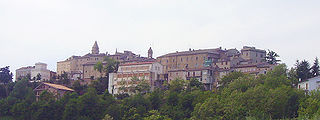
Monte Rinaldo is a comune (municipality) in the Province of Fermo in the Marche region of Italy, located about 30 km (19 mi) north of Ascoli Piceno and 25 km (16 mi) west of Fermo.
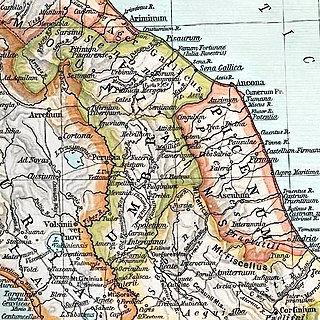
The Ager Gallicus was the territory in northern Picenum that had been occupied by the Senone Gauls and was conquered by Rome in 284 BC or 283 BC, either after the Battle of Arretium or the Battle of Lake Vadimon.

The Picentes or Piceni or Picentini were an ancient Italic people who lived from the 9th to the 3rd century BC in the area between the Foglia and Aterno rivers, bordered to the west by the Apennines and to the east by the Adriatic coast. Their territory, known as Picenum, therefore included all of today's Marche and the northern part of Abruzzo.

Septempeda was a Roman town in Picenum, now in the Italian region Marche. It became today's San Severino Marche after the fall of the Roman Empire.

The Villa dei Sette Bassi was the second-largest ancient Roman villa or monumental palace in the suburbs after the Villa of the Quintilii.
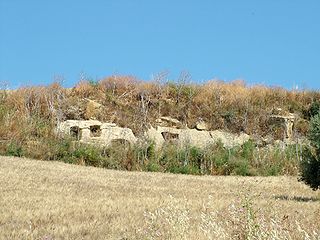
The archaeological park of Sabucina, located on the mountain of the same name near Caltanissetta, is an archaeological site in Sicily. The area contains settlements ranging from the Bronze Age to the Roman period.
Naples (Italy) and its immediate surroundings preserve an archaeological heritage of inestimable value and among the best in the world. For example, the archaeological park of the Phlegraean Fields is directly connected to the centre of Naples through the Cumana railway, and the nearby sites of Pompeii, Herculaneum, Stabiae and Oplontis are among the World Heritage Sites of UNESCO.
The gens Tuscilia was an obscure plebeian family at ancient Rome. Almost no members of this gens are mentioned by Roman writers, but several are known from inscriptions.
















